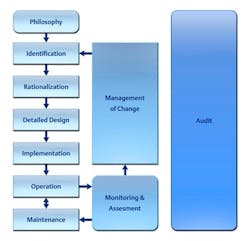Alarm Management: Pick the Real Culprit
The quest to comply with alarm management standards is taxing both human and technical resources at chemical makers — and driving developments to make managing alarms easier. Vendors such as exida, PAS, Schneider Electric and Human Reliability Associates, as well as the Center for Operator Performance are at the forefront of this activity.
Standards on alarm management have continued to evolve since the June 2009 publication of ISA-18.2, the first true standard on alarm management applicable to U.S. companies. (See: “Avoid the Domino Effect.”) Alarm management standards went global in October 2014 with the release of the international standard IEC 62682.
“Companies of all sizes are feeling more pressure to comply with the alarm management standard,” says Todd Stauffer, director of alarm management services for exida, Sellersville, Pa. “The pressure is typically applied from company senior management or corporate management and pushed down. At the lowest level, on the front line, the implementers and practitioners who have lived with the problems also feel pressure to address their alarm management issues — much of it internally generated,” he adds.
Figure 1. This lifecycle should steer efforts to develop an alarm management strategy. Source: exida.
The weak link in some cases, notes Stauffer, is company or plant middle management: “While they support the need to address alarm management issues from a philosophical point of view, their actions may speak differently. They may not actually make available the necessary resources — i.e., people — for an alarm management program to be successful.”
One common challenge is to set expectations appropriately for an alarm management program. For example, the standards give recommended KPIs, such as the number of alarms per operator per day, for alarm system performance. In many cases, these aren’t achievable over night, but will require significant effort and resources, plus both short- and long-term performance targets.
Stauffer stresses that an understanding of the ten-point alarm-management lifecycle (Figure 1) should underpin any strategy.
However, this poses its own challenges: “In many cases, end users feel that the best way to get started on an alarm management program is to jump into rationalization. This, however, is not typically a good place to start. For new greenfield systems, the best place to start is with the development of an alarm philosophy document. For an existing system, the best place to start is typically with monitoring and assessment and/or audit so that one can benchmark initial performance and identify the most pressing issues that need to be solved. The next step would typically be the creation of an alarm philosophy document to create a framework for addressing the identified alarm management issues.”
Overall, the main challenge that companies face is making the appropriate people available, he counsels. “Alarm rationalization can be a resource-intensive process and the people you want involved — process engineers, control engineers and lead operators — are typically very busy. So, setting out a reasonable timetable, for example, four hours per week in order to systematically work through the process, is important.”
Stauffer points out that on a typical shift operators make many decisions that impact the financial bottom line, from optimizing how a unit runs to preventing unplanned shutdowns to supporting preventative maintenance. An effective alarm management system is one of the best tools that you can give operators to help them do their jobs better, he believes. On the other hand, having an ineffective alarm system can negatively impact operators’ performance.
“As the discipline of alarm management becomes more mature and the impact of standards is felt more widely, companies will be able to rely on their alarm systems to drive operator productivity and efficiency,” he adds.
Figure 2. Dynamic alarm management solutions can boost plant performance. Source: PAS.
Seven-Step Method
At PAS, Houston, evolution of the early alarm management guidelines into today’s formal standards with concrete performance criteria and metrics demands has led to the development of a seven-step methodology to manage alarms:
1. Alarm philosophy development;
2. Data collection and benchmarking;
3. “Bad actor” alarm resolution;
4. Alarm documentation and rationalization;
5. Alarm audit and enforcement;
6. Real-time alarm management; and
7. Alarm system control and maintenance.
The company suggests deploying its PlantState Suite (PSS) alarm management software to initially benchmark the performance of the alarm system against industry best practices and to provide a baseline for measuring the gains of a project at completion.
“Fifteen years ago nobody was really doing anything about alarm management. Today it is recognized in industry that alarm management is important in making processes better,” explains Mark Carrigan, senior vice president of global operations. “So most companies now have an alarm philosophy written down. It’s a similar story with data collection and bad actor alarm resolution. Many companies, particularly the majors, also have carried out rationalizations and redesigns of their alarm systems to meet their alarm philosophies and applied this to their control system databases. So that’s very mature,” he adds.
For a real increase in performance, Carrigan advises, you now have to look at more-dynamic real-time alarm management solutions (Figure 2). And this is where companies can struggle with the final requirements of ISA-18.2, he adds. “Many companies find it difficult to implement practical, sustainable dynamic alarm-management strategies to manipulate alarm settings and avoid process-related alarm floods,” he points out. PSS helps them refine the seven-step cycle from comprehensive, simple input to an alarm maintenance strategy.
As the alarm management process evolves, the next step for PAS is boundary management. In February, the company signed a multi-year contract with BP Downstream to use PAS InBound to help manage critical operational limits — by capturing, visualizing, analyzing and alerting operators on boundary data within plant operations. Such boundary data include process alarms, safety instrumented and environmental trip points, mechanical design limits, normal operating zones and safe operating envelopes.
Another development is the PowerGraphiX HMI. “This was designed for the U.S. power sector because we were working with a large power producer in the U.S. and found that each of its plant control rooms had totally different graphics. So we redesigned graphics for all of their control rooms. Regardless of whether they are using ABB, Siemens, Foxboro, etc., technology, all displays look the same to the operators. It’s making the implementation of graphics at power plants cheaper and faster, with much better results — and has a wider applicability in the process industries,” notes Carrigan.
In fact, the company is heavily involved with control room design, too, ensuring that best practices are codified in a methodology that guides companies to results based more on science than opinion and art — the latter two have led to an attitude that chief marketing officer David Zahn believes has made control room design an afterthought, with results that aren’t always impressive.
“At the end of the day, no alarm or graphic used by operators either controls a plant or makes it safer. They are only information delivery machines to help human beings make decisions. Our business lies in making the information that is available to companies far more usable and their processes more successful,” he says.
Figure 3. Software under development aims to provide comprehensive analysis of an alarm system. Source: HRA.
Two Sticking Points
According to Rob Kambach, Wonderware product manager, Schneider Electric Global Solutions, Lake Forest, Calif., two major issues need tackling to improve alarm management in the chemical industry: the sprawl of alarms per operator caused by additional digital information, and need for proper classification of alarms into a maximum of four severities so that operators can respond accordingly. “The amount of alarms is one of the driving factors that make the systems unreliable, because once an operator is overloaded there is less attention to the alarm subsystem. Also, constantly responding to alarms keeps operators away from trying to improve the process,” he notes.
To address these problems, in April, Schneider launched Wonderware Alarm Adviser, an interactive web-based application for visual analysis of historical alarm data. It provides an instant view of alarm activity for a specified time period, allowing engineers to quickly analyze alarm patterns and identify nuisance alarms that can lead to operator distractions.
“Alarm Adviser by itself is a standalone product that only provides reporting capabilities. However, in the last two releases of Wonderware System platform we added a lot of features to do rationalization of alarm subsystems by adding shelving, plant state suppression, alarm aggregation and alarm border animations. Alarm Adviser gives users the intelligence to identify what is wrong with an alarm system and the ability to eliminate bad actors. Feedback from the pilots [which included chemical plants] has been very positive, particularly about the speed of report generation and the intuitive user interface,” comments Kambach.
The company is focusing much of its ongoing R&D on making Alarm Adviser central to what it calls actionable alarming, where data are shown in context. This, says Kambach, will help operators overcome the problem of dealing with very frequent alarm notifications: “In many cases a faulty design, rather than an unstable process, is the root cause of untrustworthy and nuisance alarm notifications. The presence of large amounts of noise in the system leads to a lack of operator trust in that system, resulting in genuine abnormal situations being ignored or obscured by that noise.”
For its part, Human Reliability Associates (HRA), Dalton, U.K., is working on a tool to bridge the gap between the alarm metrics provided by traditional alarm software and the lack of insight offered to the operator when the need to respond to critical alarms arises. Its Alarm Review Tool (ART), which aims to provide a comprehensive analysis of the alarm system, currently comprises four core elements: critical alarm screening, individual alarm review, alarm management system review and alarm performance metrics (Figure 3).
Although still in development, the ART software already has been tested on a chemical plant, an oil refinery and an offshore oil platform. “The main alarm analysis section is complete and now just needs more-thorough testing — we are hopeful that the refinery [at which tests already have taken place] might help us with that. The two other sections, screening and management review, are 50–75% complete. The final section, performance monitoring, just requires software development,” explains Neil Hunter, a consultant for HRA.
He adds that new funding from U.K. industry association the Energy Institute, London, will cover the cost of remaining research, leaving HRA in a position to have the tool pretty much complete by the end of the year.
Upcoming Research
In April the Center for Operator Performance (COP), Dayton, Ohio, announced that it would fund the first comprehensive, controlled study of display color in the process industries. Two researchers at Pacific Science & Engineering, San Diego, will design and conduct a set of experiments.
“The objective data would then be used to make evidence-based recommendations for background and palette color combinations over a wide range of control displays and viewing conditions. We do not expect to receive the final report for this project until this fall,” notes Thomas R. Kindervater, solution support manager, COP.
The COP also is planning two studies looking into smart alarming. One will aim to identify the benefits of smart alarming to help determine if the cost/complexity of implementation is justified. The other will explore methods for consistently and reliably applying smart alarming while maintaining alarm system integrity.
Kindervater explains the thinking behind the studies: “Currently, much of alarm management is done as an article of faith. While alarm management studies have shown that alarm rates can be reduced, does that translate into better operator performance and increased plant safety? It is assumed that it does, given alarm overload is often listed as a causal factor in incidents.”
One study will examine operator performance using a high-fidelity simulator with variations in alarm management and procedure automation. One goal of this effort is to quantify the benefits of different levels of alarm management. The other study will address the complexity of implementing smart alarming. Both studies are expected to be completed in 2016.
Looking further ahead, Kindervater believes that a game changer might emerge in the next decade — namely, the ability to reliably and accurately identify deviations in process operation from the desired conditions before they become alarms of the type used today. “Current COP research indicates reliable and accurate event prediction that points to causal factors is possible and, in case scenarios tested so far, can be determined in time to allow operator intervention to correct the situation before an upset occurs,” he says.




